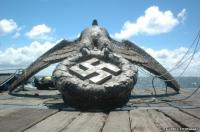 What has been referred to as the Second Battle of the River Platte, may be coming to an end. In 2010, we posted about a legal battle over the salvaging of the German pocket battleship Admiral Graf Spee which was scuttled in the River Plate in 1939. The center of the conflict is a four-ton bronze eagle holding a Nazi swastika in its talons, which was once mounted on the stern of the ship. For over a decade, there has been a three-way legal battle between the Uruguayan businessman who salvaged the eagle, the Uruguayan government, and the government of Germany, which has been concerned that the eagle and swastika will fall into the hands of Nazi sympathizers. Recently, the Uruguayan Supreme Court has ruled that the Uruguayan state was the eagle’s rightful owner, but it also decided that the private salvage company should get 50% of the profits if the eagle was sold. The Uruguayan government has not announced its plans for the eagle, which has been stored for the last decade in a climate-controlled warehouse guarded by the Uruguayan navy.
What has been referred to as the Second Battle of the River Platte, may be coming to an end. In 2010, we posted about a legal battle over the salvaging of the German pocket battleship Admiral Graf Spee which was scuttled in the River Plate in 1939. The center of the conflict is a four-ton bronze eagle holding a Nazi swastika in its talons, which was once mounted on the stern of the ship. For over a decade, there has been a three-way legal battle between the Uruguayan businessman who salvaged the eagle, the Uruguayan government, and the government of Germany, which has been concerned that the eagle and swastika will fall into the hands of Nazi sympathizers. Recently, the Uruguayan Supreme Court has ruled that the Uruguayan state was the eagle’s rightful owner, but it also decided that the private salvage company should get 50% of the profits if the eagle was sold. The Uruguayan government has not announced its plans for the eagle, which has been stored for the last decade in a climate-controlled warehouse guarded by the Uruguayan navy.
The Admiral Graf Spee was one of three heavy cruisers notionally built under the limitations imposed on warship size by the Treaty of Versailles. They were referred to as “pocket battleships” by the British. Delivered in 1933, Graf Spee was armed with six 11 in guns in two triple gun turrets, eight 5.9 inch guns in single turrets, and had a top speed of 28 knots.
In 1939, Admiral Graf Spee had been sent to cruise in the South Atlantic to be in position to begin commerce raiding once the war began in September. The British and French navies formed eight groups to hunt down Admiral Graf Spee in the South Atlantic. In December, three Royal Navy cruisers; the heavy cruiser HMS Exeter and the light cruisers, HMS Ajax and HMS Achilles; located Graf Spee off the estuary of the River Plate close to the coast of Argentina and Uruguay in South America. The Battle of the River Plate which ensued was the first naval battle in the Second World War and the first in South American waters. In the battle, HMS Exeter was seriously damaged and was forced to withdraw, while HMS Ajax and HMS Achilles suffered moderate damage but were able to continue the pursuit of the Graf Spee, which sought refuge in the Uruguayan port of Montevideo. The Graf Spee had also suffered battle damage. Rather than face what he believed to be an overwhelming enemy force, the ship’s captain, Hans Langsdorff, ordered the ship scuttled and later committed suicide.
The ship is now 8 meters below the surface in the River Platte estuary off Montevideo. In 2004, there were plans to raise the ship and turn it into a tourist attraction. The bronze eagle was recovered in 2006. A rangefinder and a 6″ gun have also been salvaged.
Thanks to Alaric Bond and Phil Leon for contributing to this post.

Also, the story was made into an excellent movie:
https://en.m.wikipedia.org/wiki/The_Battle_of_the_River_Plate_(film)
Interesting. How is it all not the property of the Federal Republic of Germany, as it is a warship?